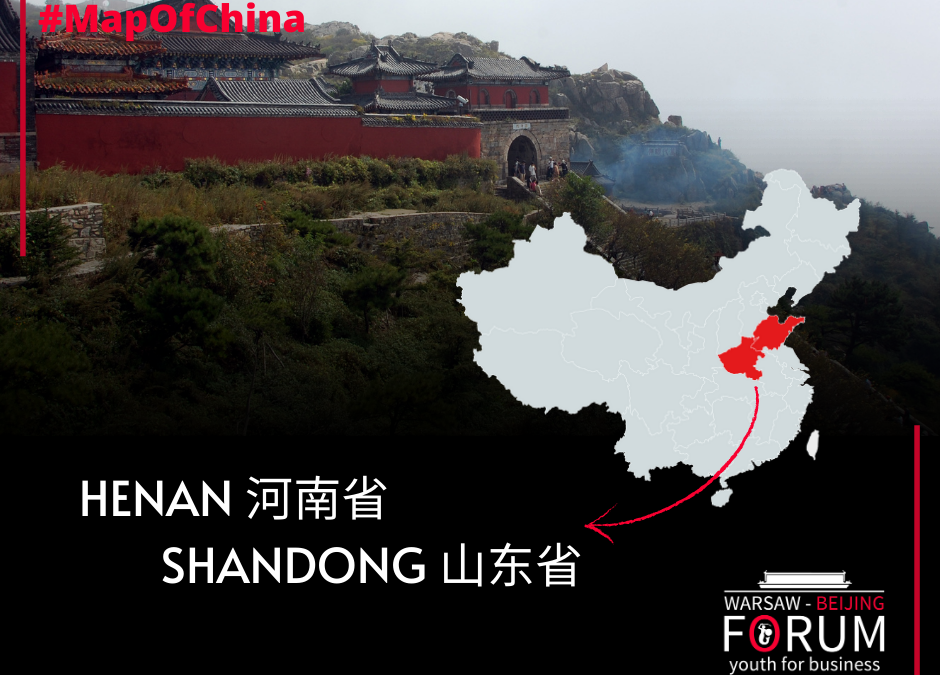Shandong 山东
Shandong is a province on the east coast of China, on the Yellow Sea. With a population of around 98 million, it is the second largest province in China, second only to neighboring Henan. The capital city is Jinan. The historical name of the province, Lu, refers to the state that was founded in this area during the Spring and Autumn period (8th-5th century BC).
Thanks to access to the sea (the coastline of 3,000 km!) and foreign cooperation, it is now one of the richest provinces, right after Guandong and Jiangsu, with a GDP of 711 billion RMB. Its convenient location enabled Shandong to grow and export fruit, grains, meat and vegetables on a large scale for centuries. The province has rich oil reserves, especially in the Dongyin area and numerous hard coal mines. It is one of the leading producers of cotton, precious metals (gold and diamonds) and saffron. The seaside location and the favorable, moderate climate also make it possible to run vineyards for which Shandong is famous.
Like many other eastern provinces, Shandong fell under the Western imperialism in the 19th century. The stigma of German colonialism is visible in the province due to the fact that in 1897, the city of Qingdao became a German concession, returning to China in 1922. Traces of German culture can be found in the architecture – part of the city of Qingdao has a typical Western style and regular street layout. You can see Catholic churches here, as well as the most famous brewery in China, Tsingtao. One of the largest home appliances manufacturers, Haier, was founded in Shandong, as a joint venture with German Liebherr.
The province is of particular historical importance as it is part of the area considered to be the cradle of Chinese civilization. Its western territories were controlled by the oldest dynasties in China – Shang and Zhou. In ancient times, the province was considered the political, economic and cultural center of China. It is here, in the city of Qufu, that Confucius was born. Shandong has also an important religious meaning. Located in this province, Tai Shan Mountain is the most important mountain for Chinese Taoist culture and religion. It belongs to one of the Five Sacred Mountains of Taoism. It is associated with sunrise and birth. It is also considered to be one of the oldest places of worship in all of China, with over 3000 years of history. Chinese emperors made pilgrimages to Tai Shan praying to the gods and paying tribute to them.
Henan (河南)
Henan Province is located in the central part of China. The Yellow River flowing through it divides the area into two unequal parts, most of which lies south of the river bed, to which its name refers (“South of the River”). It is the most populous province in China, has a population of over 108 million, and its capital is Zhengzhou.
Henan, along with several other provinces, is considered the cradle of Chinese civilization. For over 3,000 years it has been an important political, economic and cultural center. As a result, the province is home to many great monuments, the most important of which are The Archeological sites of Yin Xu, Longmen Grottoes and the historic monuments of Denfeng in the “Centre of Heaven and Earth”. Moreover, it was in Henan that the Shaolin Monastery was founded, a legendary place famous for the martial arts.
The fertile soils and the central location contributed to the development of agriculture, which is one of the most important branches of the economy, next to the food industry and logistics. The main industrial crops include cotton, silk, vegetable oils and tobacco – the province is the largest producer of tobacco in China. However, precisely because of its location, Henan was a strategically important area during all major wars – military actions and periodic floods of the Yellow River wreaked devastation on the province many times.
Considered primarily as an agricultural province, Henan has experienced an economic boom in recent years. While the economy is still based on agriculture (especially wheat and sesame) and textiles, economic changes have taken place in recent decades that have opened up the industrial sector to metallurgy, chemicals and electronics. Currently, the province has recorded one of the fastest economic growth in the country – in 2019 it amounted to about 7%, and GDP reached the value of $723 billion. The provincial capital of Zhengzhou has been transformed into a modern logistics center with a futuristic skyline, connected by high-speed rail with Beijing and Shanghai.
Author: Martyna Zwierzchowska


Recent Comments